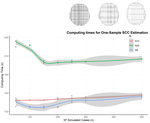Statistical Techniques for Neuroimage
 Positron Emision Tomography image to analyze and predict Alzheimer’s Disease onset.
Positron Emision Tomography image to analyze and predict Alzheimer’s Disease onset.
This project is for all topics related to my Neurosciences and Clinical Psychology Ph.D., a thesis with a clear scope towards biostatistics applied to neuroscience. For this project, I’m interested in the application of novel statistical techniques to the diagnosis of neurodegenerative diseases (i.e. Alzheimer’s disease). With this goal, I analyze neuroimage data obtained from Positron Emission Tomography (PET) in patients from control and pathological groups. To date, daily clinical practice relays on the application of software such as Matlab’s Statistical Parametric Mapping (SPM), which carries out PET data pre-processing and a rather basic statistical analysis which results in a display of voxels (i.e. in this context, voxel = pixel) which are being activated, and those that are not.
In biomedical terms, this image or Statistical Parametric Map shows which areas of the patient’s brain are active – and to what degree – and which ones are dormant or presenting a lower pattern of activation, meaning that more neurons are dead in that region. Using SPM we can observe which regions of the brain have significantly lower activation values. The information obtained from comparing a single participant’s PET image to the standard PET patterns of healthy patients (plus the experience of the physicians who visually analyse these images) is the basis for Alzheimer’s diagnosis in daily clinical practice.
SPM has a lot of powerful tools, however, what I am currently developing, is the implementation of more advanced statistical methods (such as GAM models or functional data methodologies) which are not offered in SPM without neglecting the use of the refined neuroimage processing tools it contains. With this in mind, I have processed a batch of test PET files and then proceeded to do the statistical analysis working with R – instead of SPM or Matlab – focussing on developing GAM models and functional analysis to estimate and understand these patterns of neural activity.
The main goal of my research project is to implement these statistical techniques in order to enhance the images used for Alzheimer’s diagnosis, concretely, the process of identifying one single patient as either healthy or sick in the earliest possible stage of the disease development. This is not as trivial as it sounds, as the most recent scientific literature shows that Alzheimer’s disease begins to develop even twenty years prior to its diagnosis. Finally, when this diagnosis arrives, resources of neural plasticity are completely consumed and the disease is so advanced that clinicians can only prescribe palliative treatments with no hope for even the slightest recovery. This problem is even more worrying as the number of cases is expected to keep growing by the order of millions due to life expectancy increases all over the world.
For this reason, early diagnosis of such neurodegenerative diseases is considered as one of the key challenges for medical science in this century, and machine learning techniques will for sure have an important impact on how we address this problem. For these reasons, I am also interested in integrating machine learning techniques into this research project as it seems to be an enormous field with much potential.


